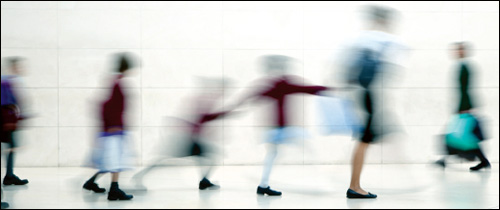Dec 01, 2012On Election Day, students and teachers at Borland Manor Elementary and North Strabane Intermediate schools in Pittsburgh's Canon-McMillan School District received an unusual assignment. They were asked to wear a three-ounce radio frequency identification sensor, or mote, in a clear plastic pouch around their necks.
The students—and others from 10 Pittsburgh public schools, grades kindergarten through 12—are part of a two-year research project, funded by the U.S. Centers for Disease Control and Prevention, called Social Mixing And Respiratory Transmission in Schools (SMART Schools). The study is being conducted by researchers at the University of Pittsburgh Graduate School of Public Health, the Johns Hopkins Bloomberg School of Public Health and the University of Liverpool. The aim is to help researchers better understand how influenza spreads through contact among children, even when they are not in school.
"Schools are a setting that can contribute to the increased spread of diseases in the general community," says Jeanette Rainey, Ph.D., senior epidemiologist at the CDC. "If we can better understand how influenza spreads in schools, that may help us develop better strategies to prevent disease not only among school-aged children but also in the general community."
In the spring, students from 10 schools were outfitted with Crossbow Technology motes programmed by the researchers to "wake up" every 20 seconds and broadcast a signal. The motes also record the ID of any other mote from which they receive a signal, the time the signal is received and the strength, which indicates the distance between the two motes. Students also received a diary in which to note their interactions with family members and others outside of school who did not wear motes.
"We looked at a variety of technologies that might provide information that is more objective and reliable than surveys asking the kids who they interacted with," says Derek Cummings, a Johns Hopkins Bloomberg School of Public Health researcher working on the project. "This also gives us an opportunity to evaluate the reliability of surveys."
On Election Day, students were given the motes to wear when they were not in school. The goal was to see how many interactions students have with others from their school when school is closed. The researchers plan to let students wear the motes for a weekend and, if possible, during a snow day, to simulate a school closing due to influenza.
"The central question is, on an off day, is there enough contact through play dates and the things kids do to sustain transmission at high levels, or is there is a dramatic decline that would make closing school an effective response," Cummings says.
The researchers say collecting this data will enable them to evaluate the most effective interventions for controlling the spread of an influenza outbreak, such as limiting movement between classes during the school day, increasing vaccination campaigns, instituting educational programs, changing sick-leave policies or implementing initiatives encouraging hand-sanitizer use.
"We plan to use the data to create models of influenza transmission both within schools and within entire communities," Cummings says. "We can then simulate different interventions to see which work best."

